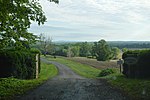Little Fork Church

Little Fork Church stands on a low knoll to the east of State Route 229 nine miles north of Culpeper, Virginia in a small grove of trees that enhances its naturally pastoral setting. The name Little Fork is taken from the junction of the Hazel and Rappahannock Rivers relatively close to the edifice. It is a large room church being 83 1⁄2 feet east–west and 33 1⁄2 feet north–south. Unlike most rectangular churches in Virginia, the pulpit stands directly north of the southern entrance door that is placed in the middle of the southern wall rather than in the far southeast of the building. Thus it shows some of the architectural characteristics of middle colony meeting houses such as those in Delaware as well as the Virginia Vernacular Church and the deep church.
Excerpt from the Wikipedia article Little Fork Church (License: CC BY-SA 3.0, Authors, Images).Little Fork Church
Oak Shade Road,
Geographical coordinates (GPS) Address Nearby Places Show on map
Geographical coordinates (GPS)
| Latitude | Longitude |
|---|---|
| N 38.599722222222 ° | E -77.955 ° |
Address
Oak Shade Road 16485
22737
Virginia, United States
Open on Google Maps







